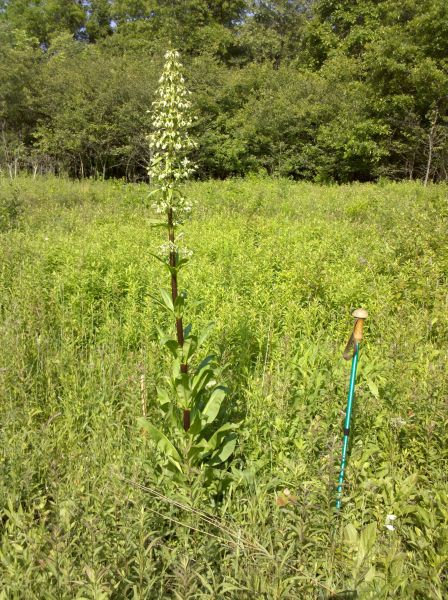
Yes, Columbo, but I’m not referring to the disheveled detective played by Peter Falk.
Last weekend I traveled to a secret meadow to find this enormous plant in bloom.
American Columbo (Frasera caroliniensis) is a member of the Gentian family and endangered in Pennsylvania. Some people call it Monument Plant, an obvious name when you consider my bright green walking stick in this photo is 3.5 feet tall. The plant is huge! (See better photos here.)
American Columbo has an unusual reproductive strategy. It’s a monocarpic perennial that grows as a rosette of basal leaves for many years without flowering. Then in response to an unknown trigger it shoots up a stalk 10 feet high, blooms and dies.
When it will bloom is a mystery no one can predict by its size or age but botanists think individual plants may bloom synchronously with other Columbos nearby. A solo plant transplanted by a botanist did not flower in 15 years of watching. Was it lonely?
Do all the Columbos in a meadow bloom at once? No. The meadow has plants of different ages because Columbo seeds are fussy. They won’t germinate until they’ve soaked up water when the temperature is about 40o F (5o C). Seeds that remained in the old seed head must wait for the right conditions to occur when they reach the ground so they won’t germinate for another year or more.
My visit to this mysterious plant ended in a bumbling detective adventure. As I bushwhacked out of the meadow I dropped my bifocal sunglasses but didn’t discover my loss until I’d hiked another half hour. I returned to the meadow to find them but I my path was obscured. I couldn’t be sure I was retracing my steps.
After a long search I found my sunglasses. Broken. Someone had stepped on them. Who?
Did I? Yes, the sunglasses fell under my feet and I stepped on them just after they fell.
Mystery solved. Thanks, Columbo.
(photo by Kate St. John)
This plant reminds me of the large succulent plant known as Century Plant (with pointy leaves ending in very sharp points/thorns). (I think they make tequila from it). It lives a long time, then finally sends up a long stem, that looks like a large asparagus. The stem “blooms” like an asparagus too — then it dies, as does its plant.
In case you haven’t heard, the Century Plant at Phipp’s is about to bloom! Here’s a link to the website:
http://phipps.conservatory.org/exhibits-and-events/index.aspx
And don’t miss out on the agave inspired drinks at the Phipp’s Friday night happy hours… margaritas!!!
Is this plant native to PA? If so, how ironic that a native plant would now be endangered. When I read your blog entries, I find myself wondering what the United States looked like, literally, before it was settled. Since I am relatively uneducated about native plants, I’m wondering how much of what I see and take for granted as ‘belonging’ really even belongs here?
Humans have literally changed the face of Earth. A powerful conept that, to be frank, is rather unsettling. The fact that the location of this plant has to be kept secret to protect it is just so disheartening 🙁
When will humanity get a grip and begin to truly steward the Earth, instead of exploit it? Will it ever happen?
American Columbo is native to PA and is endangered in both the U.S. and Canada. It’s probably listed as endangered because it is rare throughout its range. But it may never have been abundant, even in the past, because it has such a weird reproductive strategy.
Kate: Sounds to me like you saw the American Columbo in that isolated meadow near the Jennings remnant prairie, where some brush busting is necessary to access. The last couple of times I was there I saw some spectacular plants in bloom, but,more importantly, a plethora of young specimens scattered throughout.The late Virginia Phelps had a strong professional interest in this particular stand. This was still the case when she needed a great deal of assistance to visit HER plants.
I’m from BC but I take great delight in studying the native ranges of all the rare and exotic plant life that inhabit this wonderful continent of ours. I’m very disappointed to hear about the sore plight of this plant over there in Penn. and neighboring NY. I hope that nobody ever even thinks about destroying the last remaining populations of this gentian and start to realize that once you remove species from their home, there’s no coming back again. It’s as simple as that<:(
While bow hunting last fall (November 3, 2023), I came across a group of about 20 plants in a small 1/20 acre patch of open woods in Carroll Co., OH. The dried out flower heads were all covered with dark seed pods. I collected some seeds to plant near my home in Wayne Co. PA. I’m looking for the best advise available from others who’ve tried and succeeded in propagating this plant from seed.
PS I have some really great late season photos of this plant in it’s small “Autumn time” community. How do I go about sharing this information?
Thanks!
Tim
Tim, the Botanical Society of Western PA can help you. Contact anyone on this list: https://www.botsocwpa.org/contact-us.php